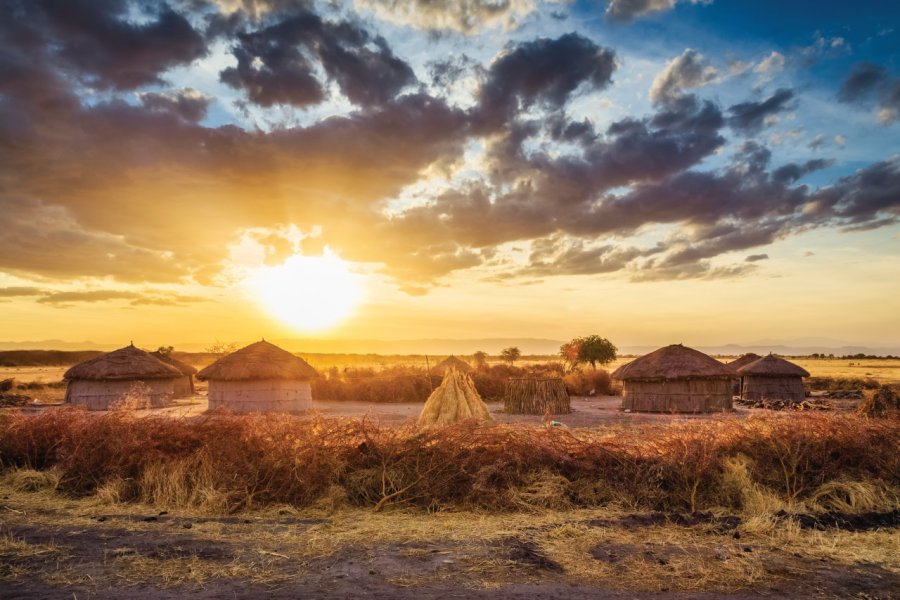Travel Guide Tarangire National Park
Find an accommodation
Advertising
The park was created in 1970. It extends over 2,600 km2, at an altitude of around 1,100 m. It is home to one of the highest elephant densities in Africa. Tarangire (pronounced Taranneguiré with a slight roll of the r's) is an absolutely superb park, easily accessible from Arusha (125 km on a perfectly paved road, less than an hour and a half). However, it's easy to incorporate it into a circuit including Manyara, Ngorongoro and Serengeti parks, almost on the same road, to take the time to observe herds of elephants. In a savannah region dotted with termite mounds, acacia trees and a fair number of baobabs, it lies on the migration route of many animals: its ecosystem runs along the Great Rift as far as Lake Natron, passing through Manyara in particular. It is also estimated that elephant numbers increase after the rainy season, due to migration. Finally, many young elephants have recently been born. In fact, until 1994, a period of drought had hit, and weakened female elephants had hardly procreated. The situation subsequently improved, and with a gestation period of almost 2 years, many calves were born at the beginning of 1996. Intensive poaching, which took place until the 1980s, had for a time decimated them, especially the older ones for their tusks. In any case, they are now relatively overpopulated: the park's vegetation is somewhat ravaged, particularly the baobabs, whose bark they strip off (this is when termites attack, piercing the tree right through).The park's main track runs north-south along the Tarangire River, where the animals usually come down to cool off during the day, before heading back up into the hills in the evening. The area to the far north is called Lemmiyon, where the wildlife is often quite abundant but relatively classic.Further south, the Burungi circuit and then the Kitibong area on the west side are often inhabited by large groups of elephants; on the east side, we head for Matete. The best way to start is to follow the river in all directions, as far as the Kuro ranger station, from where you can head for the Larmakau swamps, home to many birds, and where lions sometimes wait for prey to come and drink. The entire southern half of the park remains, but is only crossed by a handful of much less well-maintained tracks. It is said that in the south, there are fewer animals but more rare specimens. Beware of the risk of silting up when crossing the Tarangire River: some people have had to spend the night in the riverbed. The best time to visit the park is from mid-August to mid-December. During the main rainy season, from March to May, the vegetation is a little overgrown and the animals are somewhat hidden. On the other hand, there won't be many of you in the park.Smart tip. This park is famous for its tsetse flies in the hot season, just before the rains, which have protected it from any lasting human occupation since time immemorial, and above all for its elephants. Tsetse flies (which means "fly" in Swahili, actually horseflies for elephant skin), it's absolutely essential to dress in light colors with fairly thick clothing, as these gadflies bite through clothing and are particularly attracted to navy blue and black, during the day, and invite themselves into your 4×4. No mosquito repellent will do - they vibrate to color! Their bite is extremely painful, especially from the second day onwards, and can transmit sleeping sickness caused by the trypanosome parasite (although the probability is very low if you stay in the park for a few days, it does exist).
What to visit Tarangire National Park?
Suggested addresses Tarangire National Park
Weather at the moment
Advertising
Organize your trip with our partners Tarangire National Park
Transportation
Book your plane tickets
Car Rental
Boat rental
Accommodation & stays
Find a hotel
Holiday rental
Find your campsite
Tailor-made trip
Immersion travel
Services / On site
Activities & visits
Find a doctor
Tarangire National Park travel inspiration
Find unique Stay Offers with our Partners
Pictures and images Tarangire National Park
Other destinations nearby Tarangire National Park
5 km away
100 km away











